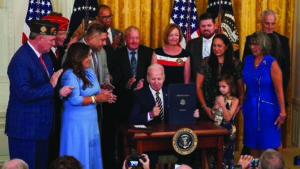Breathing Easier

Vanderbilt University Medical Center pathologist Joyce Johnson, MD, was pulling into her driveway when she heard the news that the U.S. Senate had passed a bill to expand health care benefits for veterans who became ill after exposure to open burn pits and other toxins during their military service. She sat alone in her car and cried.
“First, there were tears, and then I sent Bob a text,” she remembered. “He answered back, and we had quite a jubilant moment. You know, I’ve been carrying this around for a long time.”
Johnson, a professor of Pathology, Microbiology and Immunology, specializes in the pathology of lung diseases, and “Bob” is her longtime colleague at the Medical Center, Robert Miller, MD, the Patricia and Rodes Hart Professor of Medicine.
Johnson, Miller and a tightknit group of pulmonologists, surgeons, pathologists and scientists at VUMC have worked together tirelessly for the past 18 years to gather and present the evidence that millions of veterans exposed to airborne toxins during their deployment in Iraq and Afghanistan were potentially left with very real, life-changing lung injuries.
The Sgt. First Class Heath Robinson Honoring Our Promise to Address Comprehensive Toxics Act, otherwise known as the PACT Act, was signed into law by President Joe Biden on Aug. 10, marking the most significant expansion of VA health care in three decades. The law is named in honor of Robinson, a decorated combat medic who died from a rare form of lung cancer. Robinson’s widow and daughter, Miller, and several VUMC patients and families were in the room when Biden’s pen hit the paper.
The PACT Act expands Department of Veterans Affairs medical care to an estimated 3.5 million post-9/11 veterans who were exposed to airborne toxins, including those coming from burn pits, trash sites that disposed of waste in Iraq and Afghanistan through open burning. The act also adds 23 new medical conditions to the VA’s presumptive list for toxic exposure and is expected to result in new health care facilities being added across the United States to serve veterans seeking diagnosis and care as a result of the legislation.
“I feel good about this; this is a victory,” Miller said. “I am pleased that post-9/11 veterans are receiving this attention. It has taken years to get to this point, but at least it did not take 40 years, as seen with Agent Orange exposures associated with service in Vietnam.
“The big thing this act does is that it specifically relieves the veteran of the burden of proof that an illness associated with toxic substances is service connected,” Miller added. “If you have a qualifying diagnosis, with the passage of this act, it will be treated as if it is deployment related.”
Home Sick
A medical mystery began in 2004 when soldiers from the 101st Airborne Division based in Fort Campbell, Kentucky, returned from deployment in Iraq complaining of shortness of breath. Many were so winded during 2-mile runs they could no longer pass the standard physical requirement to remain in active service.
Conventional medical tests — lung imaging and pulmonary function tests — were performed at Fort Campbell, and the results of nearly all the tests were normal. Fort Campbell then sent more than 50 soldiers to Miller for further evaluation between 2003 and 2005.

Miller made an unconventional recommendation for surgical lung biopsies, an invasive procedure that involves a chest incision to extract tissue. He made a convincing case for the need, despite a lack of other diagnostic or imaging abnormalities, to Eric Lambright, MD, a thoracic surgeon at VUMC and the current chief of Thoracic Surgery at the Nashville VA Medical Center.
Johnson remembers being taken aback when the pathology requests reached her inbox.
“I had no qualms about calling Bob and saying, ‘What are you doing?’” she remembered. “He detailed for me — and of course I could read their charts — just how symptomatic and limited these individuals were. Bob is a seasoned clinician, so that was good enough for me. I was skeptical in the beginning, but when I started looking at the biopsies, I realized where the problem was.”
If one pictures the lungs as an upside-down tree with the trachea as the trunk and the air tubes or primary bronchi as branches, at the end are structures resembling clusters of grapes called alveoli. This is where gas exchange occurs, with oxygen coming in and carbon dioxide going out.
“When you have any inhalational injury — not only burn pits, but if you breathe in particles from woodworking or you’re a coal miner breathing in dust — those particles are on the airflow as you breathe in and out,” Johnson explained. “That tends to settle out and cause damage at the farthest tree branch just before you reach the alveoli, the small airways. These small airways or bronchioles can become inflamed and scarred by whatever has been breathed in.”
All but a few of the biopsied soldiers received pathology reports diagnosing constrictive bronchiolitis, a narrowing of those smallest and deepest airways. It is an irreversible, chronic condition, and can currently only be diagnosed through biopsy. Johnson likens the condition to breathing through a straw, with no expansion of lung capacity during exercise or whenever the body needs more oxygen.
Miller and his VUMC colleagues published their findings in 2011 in the New England Journal of Medicine. The paper generated much interest, both within the military and in the media. Miller and other authors also presented their findings before national meetings, including panels convened by the Department of Defense and Congressional subcommittees.
After the publication, Johnson, who was also at the time the service chief for Anatomic Pathology at the Nashville VA Medical Center, found herself challenged by fellow pathologists, both publicly and privately. And a military pathologist at the federal level who reviewed the same tissue proclaimed she saw no evidence of lung injury.
Despite the naysayers, Miller believed the 2011 NEJM paper would set the ball rolling toward confirming a connection between military deployment to the Middle East and lung injury, but action on the issue stalled. He said it then became a personal “cause for advocacy.”
Jim Raines, who served in the 82nd Airborne Division of the U.S. Army, underwent a lung biopsy at VUMC. He was deployed to Afghanistan from December 2006 to December 2007 and was often on duty near burn pits. Chemicals, medical and human waste, weapons, ammunition, petroleum and other garbage burned around the clock, sending up jet-black plumes and casting a haze in the skies for miles.
“Then, at 43 years old and at an elevation where the air is thinner, I could run 2 miles in 16 minutes,” he said. “I was in excellent physical shape. After I came back, I started having problems. I was slowing down on my runs, and I would develop chest congestion and flu-like symptoms after I would complete my physical fitness tests.”
Building the Science
In December 2021, a VUMC team led by Sergey Gutor, MD, PhD, and Vasiliy Polosukhin, MD, PhD, published a study in the American Journal of Surgical Pathology with in-depth histopathological analysis of the veterans’ lung biopsy samples. They examined 50 biopsies from veterans and 25 control biopsies. The pair spent years carefully measuring every structure in the tissue.
Their findings not only supported the initial conclusion by Johnson of constrictive bronchiolitis but also noted additional abnormalities such as diffuse fibrosis of surrounding alveolar tissue, thickening of the arteries adjacent to the small airways, fibrosis and thickening of visceral pleura and a threefold increase in the presence of immune/inflammatory cells.
Because of these findings, they proposed “post-deployment respiratory syndrome” as a better descriptor of the combination of inhalational exposure to toxins during deployment, post-deployment respiratory symptoms, and complex pathology in all distal lung compartments.
Polosukhin and Gutor have also created a mouse model with mice exposed to similar airborne toxicants and a control group without exposure. The exposed mice developed lung injuries mirroring those documented in the veterans’ pathology reports. The group plans to continue its research to see how these injuries might progress over time as well as to build more data that might drive treatment recommendations.
“When they published their study, I was so excited,” Johnson said. “The small airways numbers they recorded felt like a vindication. I had been telling Bob for years that the pleura was normal and none of the other structures were affected, but the measurements Polosukhin and Gutor did showed that was not correct. That shows the power of careful analysis, measurement and computerized data management that allowed them to show there was clearly more abnormality.”
Timothy Blackwell, MD, director of the Division of Allergy, Pulmonary and Critical Care Medicine and director of VUMC’s Center for Lung Research, also sees patients at the Nashville VA Medical Center and has supported and participated in his group’s work on this issue from the beginning. He laughs when recalling the hours Polosukhin and Gutor spent analyzing biopsy samples. But he says their work has been a game changer.
“You just can’t argue with that data,” said Blackwell, the Rudy W. Jacobson Professor of Pulmonary Medicine. “I believe, in large part, the reason this legislation passed is because the data became incontrovertible that there was something going on here.”
Calling in More Troops
When now retired Army Capt. Le Roy Torres returned to Texas in 2008 after deployment to Iraq, he was experiencing shortness of breath and other troubling symptoms. He had been on duty daily beside a 10-acre burn pit at Camp Anaconda.
He returned to work as a Texas state trooper, but by 2010 he was struggling to perform his duties. He requested assignment to a different job with the Texas Department of Public Safety but was denied. He was told to provide medical evidence that he was really ill.
In 2010, Le Roy and his wife Rosie learned of the work being done at VUMC and traveled to meet Miller. A lung biopsy revealed constrictive bronchiolitis, a diagnosis they accepted with both great relief and sadness.
Determined to help other veterans, the couple soon co-founded a nonprofit organization called Burn Pits 360. They created a burn pit exposure registry and encouraged Congress and the VA to address deployment-related illness. And they watched a decade pass by in frustration.

When Rosie saw talk show host and comedian Jon Stewart and 9/11 survivors’ advocate John Feal successfully lobbying Congress to fully fund health and compensation programs for responders of the Sept. 11, 2001, terror attacks, she reached out to them.
She pointed out similarities in toxins released during 9/11 and the toxins associated with deployment. Le Roy remembers it wasn’t long before his phone chimed, announcing a FaceTime video call from his wife. When he answered, he instead saw Stewart on the screen. Stewart promised him he’d fight for the veterans’ cause.
“That call brought up so much emotion, and it gave me a second wind,” Le Roy said. “It gave me the encouragement I needed to stay in the fight.
By February 2019, Stewart, Feal, the Torreses and Miller, who filled his suitcase with data, were meeting on Capitol Hill with lawmakers, including Sen. Kirsten Gillibrand (D-N.Y.), one of the authors of the 9/11 legislation. Gillibrand’s office drafted a bill, along with Rep. Raul Ruiz (D-Calif.), who championed it in the House.
When the legislation stalled in the Senate, Rosie was standing beside Stewart when he voiced his anger over the delay on national newscasts. Torres, along with veterans and other family members, spent the night on Capitol Hill. She curled up on a park bench. The next day, they were inside the Senate chamber as the legislation passed, 86-11.
Moving Forward
VUMC pulmonologists Michael Lester, MD, and Bradley Richmond, MD, PhD, who both specialize in chronic obstructive pulmonary disease (COPD) and other small airway diseases, have completed a small pilot study enrolling some of the veterans who underwent lung biopsies as well as a control group. They are looking at whether new imaging techniques can be used to screen symptomatic veterans which could reduce the need for a surgical biopsy for diagnosis.
“We are working with a vendor called 4DMedical that has developed a technology that allows real-time lung imaging,” Lester said. “Instead of getting static images of the chest as we do with typical CT scan and comparing them through some of the more advanced CT methods that are available, the new technology allows us to build a map of the chest and then watch how a patient breathes and how air moves in different parts of the lung during the respiratory cycle. We are now doing a final analysis of those results.”

“It has been an 18-year journey, and all of us at Vanderbilt have had to defend our findings with a number of entities,” Miller said. “We have regularly reevaluated our findings and return to the same conclusion; deployment has caused lung injury in a lot of those deployed to Iraq and Afghanistan.”
But the work is not over, particularly for the VUMC team.
“We’re still going to have to advocate for veterans,” Miller said. “We need to make sure that the implementation of this legislation goes the right way and goes far enough to help veterans with respiratory disorders. And processes must be put in place to appropriately evaluate this group of people. We’re not done yet,” he said.
“We’ve really moved into trying to be the center that not only identified this disorder, but also that takes the lead in understanding what the natural history of the disease is, what other manifestations might be, and then how to better diagnose it,” Blackwell said.
And the implications of these small airway injuries extend beyond the veterans, he added.
“This also has big implications in pulmonary medicine because this also happens in industry and in other areas where low-level pollutants exist,” Blackwell said. “This is something that we as a field need to get our brains around and think about how to deal with this going forward.”
Veterans including Raines and Torres are grateful for the VUMC team, and they acknowledge that their data drove the passage of the PACT Act.
“I’m very appreciative to Dr. Miller and the other doctors there at Vanderbilt,” Raines said. “They’ve been bulldogs, and they’ve not let this go. I’m thankful for everything they’ve done for me and for all the other veterans.”
Torres echoed that, saying, “I’m beyond grateful for the work of Dr. Miller and his Vanderbilt colleagues. And it was such an honor to have Dr. Miller there with us at the White House as the PACT Act was signed. To us, he’s an absolute hero. He stood his ground, even when he was being challenged and things were difficult. I know that many, many lives will be saved because of this team’s work.”
Johnson is the daughter of a World War II gunnery instructor, and caring for veterans has always been an important part of her career. She realizes waiting so long for a diagnosis and then for the PACT Act has been difficult for veterans.
“The scientific community is a bunch of skeptics, and for good reason, and things moved slowly,” she noted. “Meanwhile, these veterans were aging and getting sicker. I just want these men and women to know they were never forgotten. It must have looked like nothing was happening, but we were all toiling behind the scenes trying to make it go. We’ve never let go of this because they deserve good care.”

January 7th, 2023
Great article. It’s about time these terrible conditions, such as COPD, in vets were recognized. Let’s just hope progress moves quickly so they can all get the treatment they deserve.
January 19th, 2023
Thank you to the doctors for advocating for these veterans and for sharing this story. As a wife of a retired veteran, I know the sacrifices they make for our country. It is amazing the steps these doctors took to prove their findings – they are heroes! How sad that it took so long for this to be validated so the veterans could receive the care they need. Prayers for them and their families. They deserve our gratitude for their sacrifices.
January 20th, 2023
Thank you for this article. Two things: I am the daughter of a WWII/Korean War Veteran and appreciate the long fight to this amazing victory. And, I am a VUMC employee who is proud to work for an organization that takes up the cause for equitable medical care.
Thanks to all for your hard work and never giving up on the cause.
Best,
Tammy Hammond-Loth
VICC
January 20th, 2023
Thank you for this! I can only imagine the time put in collecting data to back up such a concerning problem for our veterans, including my father. He served the Marine Corp for 20 years, worked burn pits in Vietnam, and sadly passed away from complications of IPF. I always felt his IPF was due to the burn pits of Vietnam, but not much information was available then. What an unrelenting and debilitating disease. I am grateful for your dedication to this!